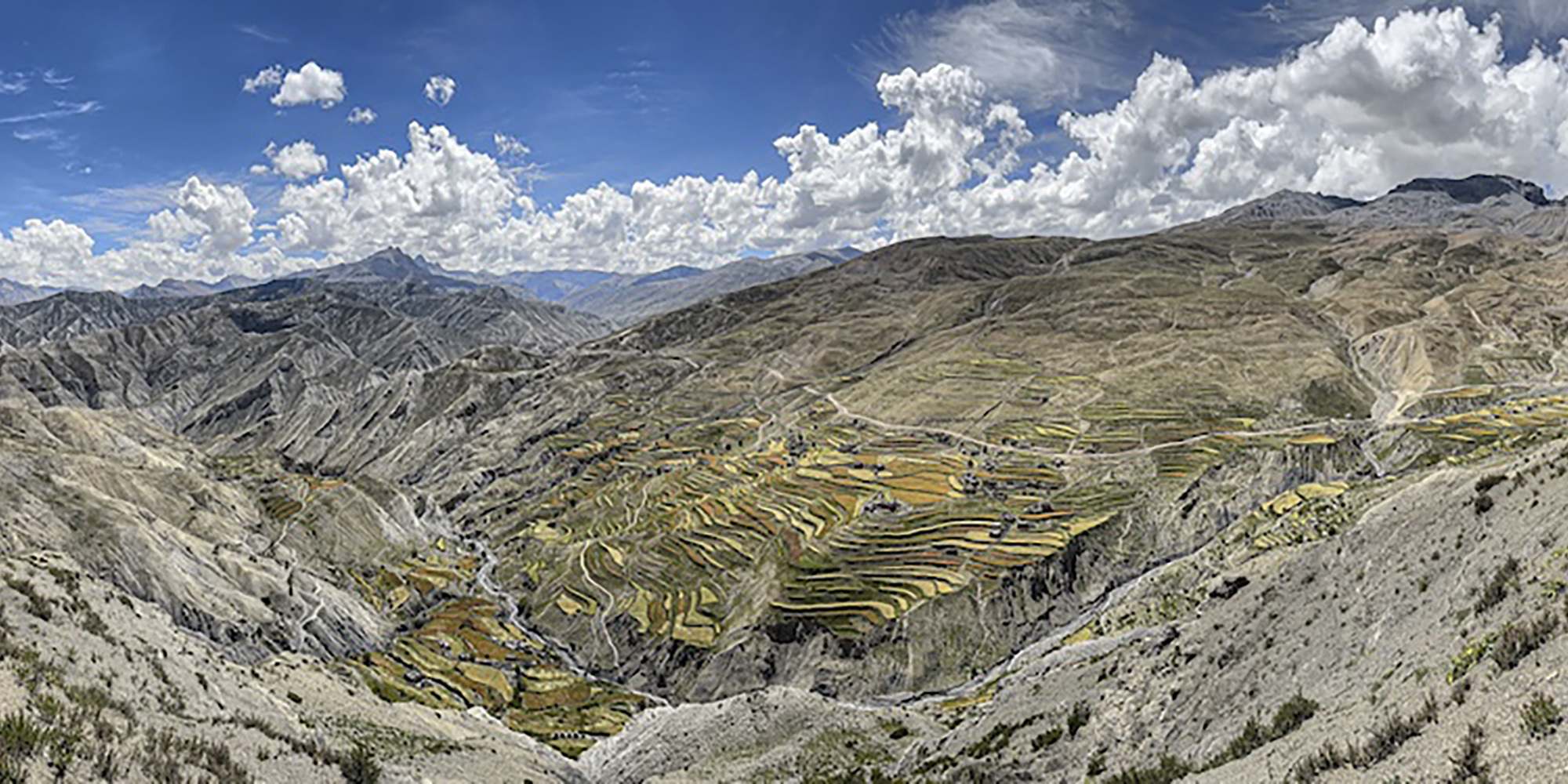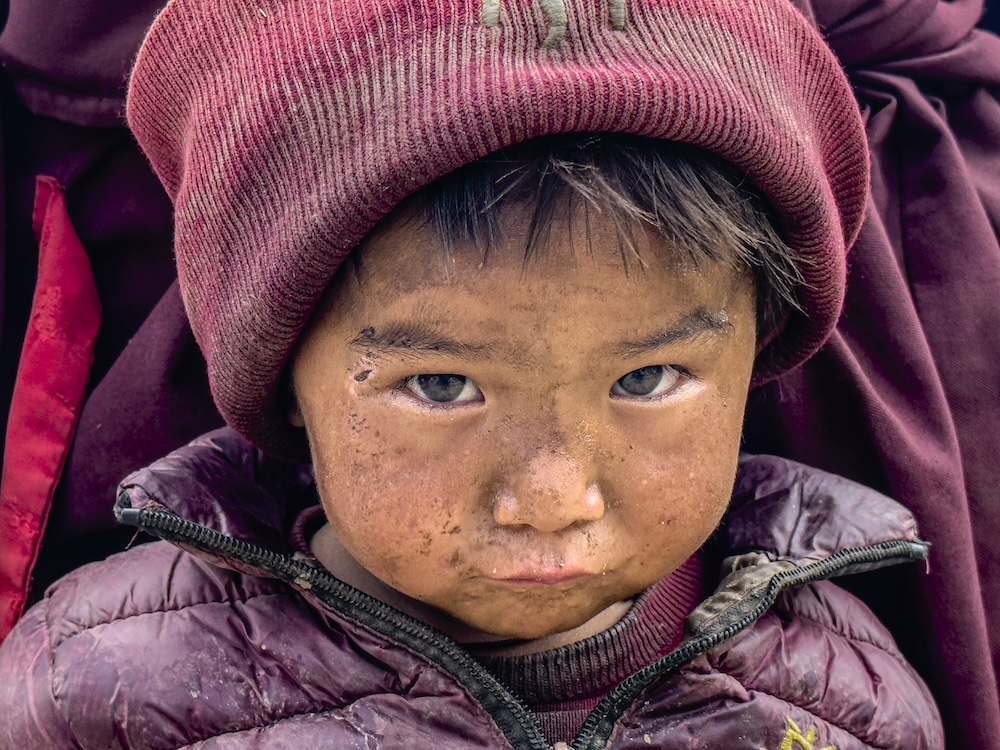
Ultimate Dolpo with a Twist
For years now, I’ve been travelling through Dolpo, my favorite region in Nepal. I must confess. During my own GHT, I chose a very special version. I left via the Kekyap la and went straight to Lo Manthang, crossing the Saribung pass to reach the village of Phu.
Lately, I’ve been spending 42 days in a row to get even more of a feel for the region. Here’s a look back at this anthology trip…
The tracks are progressing for the good of the Dolpo-pa, but in the long term they are a hindrance to the trek. Sometimes there is no plan B left. The construction machinery goes for the simplest route, often using ancestral paths. Motorbikes have already made their appearance, but fortunately we are still a long way from the hordes of four-wheeled vehicles. The terrain being what it is, every time the monsoon passes through, all the gullies destroy the tracks. There’s nothing left for a vehicle to pass through. For the caravans of yaks and mules, however, it’s a real time-saver. And that seems to delight a number of people. The transit of goods is much quicker.
Even so, for us trekkers, it’s not very pleasant walking on these tracks. It must have something to do with the brain. The path is so easy, and yet we almost get bored, even though the scenery is magnificent.
It’s as if humans need variations in the rhythm of their steps to appreciate it. A break in the progression, a movement in the terrain that gets in the way, a moment’s thought about where to put your foot and suddenly everything becomes a pleasure. The monotony of walking on flat ground doesn’t offer the unspeakable pleasure of a winding path.
So we had to check the progress of these trails (and update the maps) while taking the time to discover the whole of this magical Dolpo, which we began to appreciate thanks to Corneille Jest, then Eric Valli, Peter Matthiessen and George Schaller.
In the footsteps of our illustrious predecessors, no less.
If you want to get away from these new tracks, you have to reopen the maps, even if they are not up to date, and look for the variants, those famous variants off the traditional circuits and above all off the caravan routes.
Initially, it is best to arrive from the west, from Lake Rara and the Mugu region. Once you leave Silen Chaura (kharka for mule caravans), you are plunged straight into a world of passes and snow-capped mountains. One pass follows another, but we are not yet in Dolpo, and we have to wait until we reach the village of Pho to say to ourselves: “I’m here at last”. The few paths that allow this approach are maintained by those who collect Yarsagumba (a Thitarodes caterpillar colonized by a Cordyceps fungus) in late spring. A blessing in disguise. Without this harvest for Chinese (aphrodisiac) and Tibetan (tonic) medicine, this entrance to Dolpo would have disappeared a long time ago.
This region of Dolpo conveys an image of rolling mountains where the peaks towards the north and Tibet form a barrier that few passes cross. There are many villages here, and before the arrival of autumn and then winter, it’s a real plunge into the heart of the cultures. From soft green and pink to the warmest colors, as the days get shorter. Before returning to a black earth, at rest, waiting for spring. So, it’s via Pho, Kugaon (the last village in Dolpo), Bhijjer, Tata, Shey Gompa, Namgung, Saldang, Karang, Lurigaon, Nisalgaon, Musigaon, Shimen, Tinje – Tinkiyu, Chharka, Mukutgaon, Seri, Pangagaon, Dho Tarap, Tokyu, Ringmo… that Dolpo opens its doors to us. A guarantee of encounters, the DNA of a trip to this region.
But this is the Himalayas, so there are plenty of passes (12) on this major itinerary. The highest culminates at 5750m (the Mukut la), enough to delight us walkers. It also offers a second option, one that allows you to get up close and personal with the high peaks that encircle Dolpo. We’re talking about the Dhaulagiri here. To be more precise, we should be talking about the Dhaulagiri. Crossing this pass, Dhaulagiri II, III, IV and V block the horizon to the south. Then, as we head back towards Dho Tarap, it’s Dhaulagiri I in all its splendor that accompanies us along what might be called the third variant. The one with the forgotten villages, the one with the views of these legendary peaks, which practically belong to another journey if you don’t make the effort to come to this isolated part. There is always some form of reward in the effort. A second mantra?
This intermediary period just before the harvest allows you to take advantage of a brief moment when everything seems to come together to get as close as possible to the life of the Dolpo-pa. The caravans are in full swing, goods need to be transported before the passes close. A large number of people have returned to the village to gather plants to feed the small livestock throughout the winter. But above all, it’s time for the first harvests. The mountain pastures are slowly abandoned to tend the fields (barley, potatoes, buckwheat, mustard, etc.). When the date given by the monk for the start of the harvest arrives, the slightest patch of land is in turmoil.
A glass (or bottle) of chang (fermented drink) in the evening and the tiredness seems to disappear. There is, however, an old belief that attributes the following phrase to Guru Rinpoche “A Mathieu Ricard or nothing”, but nothing could be less certain.
And yet, in some kharkas, as long as there is still good grazing for cattle, sheep and goats, the women (for the most part) devote their day to producing the butter that will get them through the winter. The butter is offered from time to time, but it’s mainly yoghurt that can be eaten as much as you like. Impossible to preserve in these high mountain pastures, on its own or with tsampa (roasted barley flour), it allows you to share a brief moment with these high-altitude shepherdesses.
Although we do our best to stay high up, the terrain means that we have to descend regularly. There are no plans to avoid the villages and, above all, this 42-day itinerary has taken the option of visiting the most isolated hamlets, forgotten by a tourist industry already keen on unusual places.
Kugaon is one of these. Far to the north, it requires a long diversion after Pho before reaching Bhijjer. But it offers the chance to immerse yourself in an environment where everything seems frozen in time. Chörtens galore, a noticeable absence of metal sheeting, monasteries from another age. All the things that make long-distance trekkers happy. Nyingmapa Buddhism is predominant, but the Bön religion (considered to be the set of pre-Buddhist beliefs) also survives. You can discover its richness in some of the gompas dedicated to it. These two religions come together every 12 years during the pilgrimage to the Crystal Mountain at Shey Gompa in the Year of the Dragon.
Then, in the tradition of these lost villages, there is Sungjer Gompa on its unusual promontory. It dominates the valley of the Tora Khola. This is a nice alternative route to the monastery of Yangser Gompa, via small paths that are still used today, crossing Lurigaon. This village can normally be seen in the distance. It is necessary, from time to time, to take an interest in these villages which usually only appear in the distance in our field of vision. It’s a necessity if you want to really get to grips with Dolpo.
Mukutgaon is one of them. Far to the south, it is the last place before the famous Dhaulagiri. The gateway to all the tutelary gods sheltered in these icy peaks. A last ounce of humanity before entering a mineral universe where everything is a fight for survival.
But let’s face it: everything comes to an end, even the most complete itinerary. We might as well keep taking the side roads. The choice is obvious: the Schaller trail. A hodgepodge of trails that takes in the eastern shore of Lake Phoksumdo. An alternative way to see the Kanjirowa massif, the natural barrier to the west of Dolpo. It’s a trail where the gorges become deep, the dense forest takes over, and the paths hide as if to challenge the visitor one last time. But in the back of your mind, you’ll always hear the same mantra: “some form of reward for the effort”. The turquoise lake is the ultimate reward. It marks the end of a major itinerary. Another monumental waterfall, a few more days at altitude on increasingly well-marked trails and the hiker-dreamer is propelled towards a certain urban frenzy.
42 days of trekking in the heart of Dolpo may have seemed like a tall order. But as the days passed, step by step, an intuition became obvious. Giving time back to time for in-depth discovery, whether deep in the Himalayas or in the heart of our mountains, should be the central pillar of any itinerary.
Itinerary details:
Although there are several options for entering Dolpo, the best (for me) is via Lake Rara. It takes 10 days to approach from the north-west and reach the first village: Pho.
For this 42-day itinerary, I chose to start with a loop that takes us to a forgotten area in the far north: Kugaon, before reaching Bhijer.
Then on to Shey gompa (a must), before heading due north to another forgotten village, Lurigaon. This makes it easy to reach Shimen and Tinje. From there, it was time to discover the valleys farthest from the classic trails. A route as close as possible to the Tibetan border, allowing us to reach Chharka.
The route again takes an unusual direction to reach the Mu la pass, before being propelled up to face Dhaulagiri II and reach the village of Mukutgaon.
Another little-used stretch for a day’s rest in Dho Tarap.
As it’s difficult to avoid the Rac de Phoksumdo, there was only one option left: to use the Schaller trail, which gives us the most beautiful way of discovering this lake.
All that’s left is to take the classic route back to Juphal
For more information about Laurent and his treks, see tekenessi.fr





























